Animals of the tundra are adapted to living in some of the harshest climates of the world. The tundra can be one of the least welcoming natural habitats of the world for animals.
All animals living here are adapted to the harsh climate, the temperature of the tundra, and the little vegetation that grows in such places. Some animals of the tundra go to extreme lengths such as hibernating up to 8 months per year while others may remain active even on the coldest days.
Table of Contents
What is a Tundra?
The tundra is the coolest biome of the world with limited biotic diversity.
It’s represented by short flora (mosses, shrubs, etc.) and cool climate fauna. Formally known as a type of biome, the tundra flora and fauna respond to environmental factors, such as low temperatures and permanent frost.
Tundra biomes can be local or widespread. Some types of tundra even spread over multiple continents.
Short vegetation is the only type of vegetation found in the tundra. Animals that eat this vegetation (or other animals) still live here. Shrubs and mosses are common in the tundra.

Types of Tundra
1. Arctic Tundra
Found in The Northern Hemisphere, The Artic Tundra is a biome spreading around The Arctic and Southwards up until the first coniferous forests.
This is one of the coolest climates on Earth with limited fauna or very basic plants and a limited number of animals.
Only a few shrubs grow here, all without deep roots given the soil here is frozen almost throughout the year.
2. Antarctic Tundra
One of the coolest places on The Planet, The Antarctic is home to The Antarctic Tundra.
Too cold and unhospitable for plants and animals, The Antarctic is still home to hundreds of species of plants and animals, mostly concentrated on the Northeastern territory known as The Antarctic Peninsula.
Also known as The East Antarctic Tundra, this is a place of rich vegetation diversity with species such as mosses spreading around ice-free land.
3. Alpine Tundra
Alpine tundra is found all around the world, at high elevations. This is a cool area with high winds and long winters which doesn’t support tree growth or the highest variety of animals.
If the Alpine tundra is mostly found at high elevations around the world, it tends to be found at lower elevations and even at sea level when closer to The Arctic tundra.
All plants here are short. This includes various mosses and grasses.
Temperatures here are highly variable. For example, some alpine tundra biomes never get warmer than 50 °F (10 °C) in the summer.
Animals in Arctic Tundra
1. Reindeer

Reindeers (Rangifer tarandus) are a type of deer highly common in The Arctic Tundra and on 3 continents.
This species of deer is found in Europe, Asia, and North America.
Both migratory and non-migratory, Reindeer is a type of deer that may be partly domesticated.
Its wild herds and semi-domesticated herds are highly common in the Siberian tundra, where there are years when more than 1.000.000 reindeer are estimated to live.
Large reindeer populations are also found in boreal areas and the mountains of Norway.
Reindeer also live in North America, Canada, and Alaska. These types of deer live in The Canadian tundra in the summer, migrating to the taiga (boreal forest) in the summer.
2. Muskox
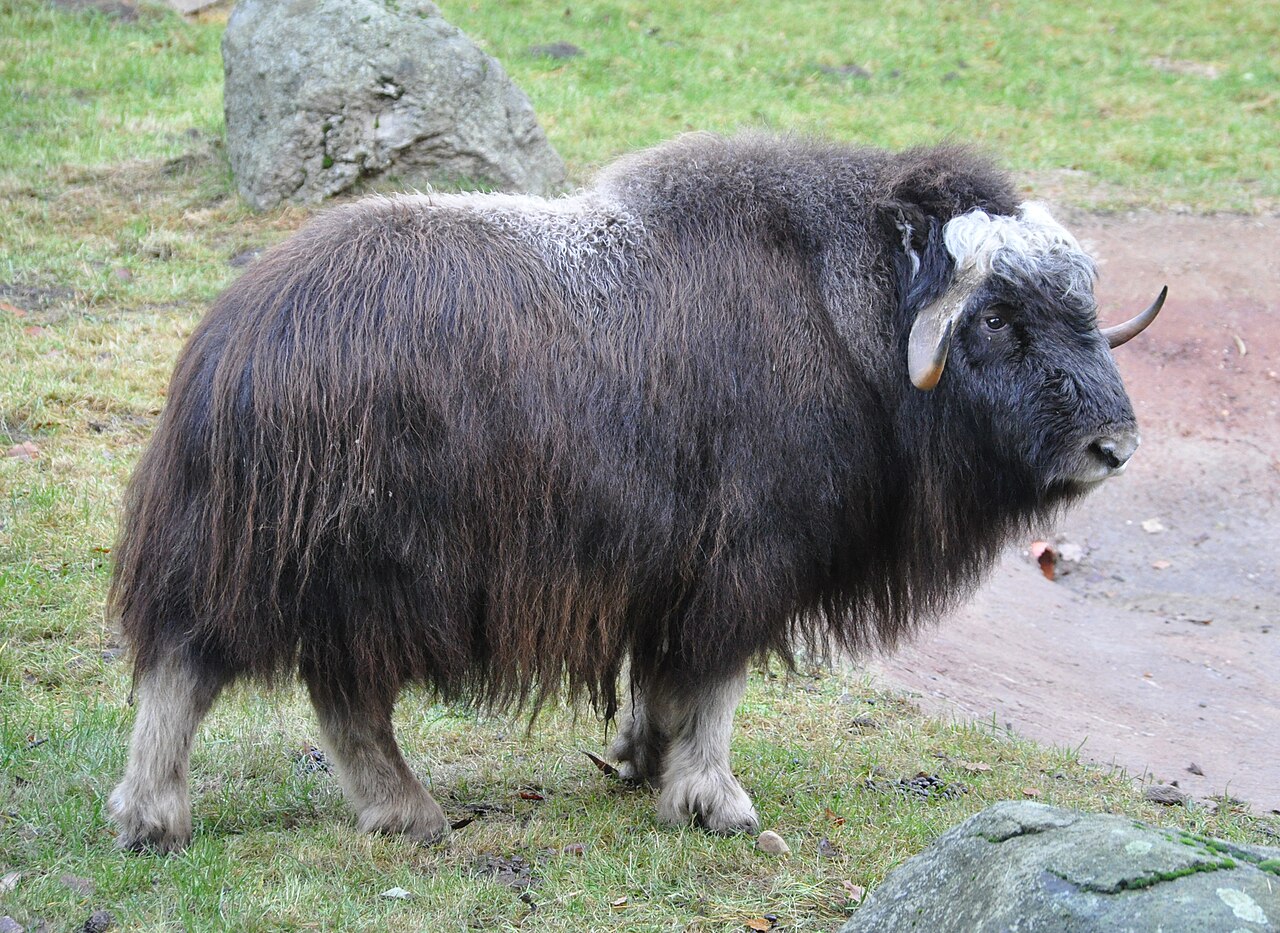
Muskox (Ovibos moschatus) is native to The Arctic Tundra. These types of bovids have thin brown coats that help them survive extreme freezing temperatures.
Male Muskox are known for their strong odor during the breeding season.
A species with curved horns, Muskox grows to a height between 3 and 4 feet and is often associated with prehistoric animals.
The number of worldwide Muskoxes varies. Some of the most positive estimates show there are still around 120.000 Muskoxes in the world.
The long history of this species even shows ovibovine Muskoxes have sheep-based roots in Asia. They have adapted to the tundra transitioning from more temperate climates.
Siberia was the initial habitat of the species, with mass migration believed to bring the populations to North America.
3. Arctic Hare

This species of hare (Lepus arcticus) is found in The Canadian tundra and Greenland.
A species of white jackrabbits, it shows adaptations such as having short legs and short ears.
Arctic Hares can also dig to escape the cool weather of the winter.
This is also a species that shows the capacity to molt and change colors to brown nuances, particularly for the species in Canada.
Arctic Hares don’t hibernate and remain active looking for plants to feed on as they’re herbivores.
Some of the few tundra plants they can feed on (apart from the rugged coastal lands they inhabit) include Arctic willow.
This small shrub found in Canada and Greenland makes up almost their entire diet.
4. Arctic Fox
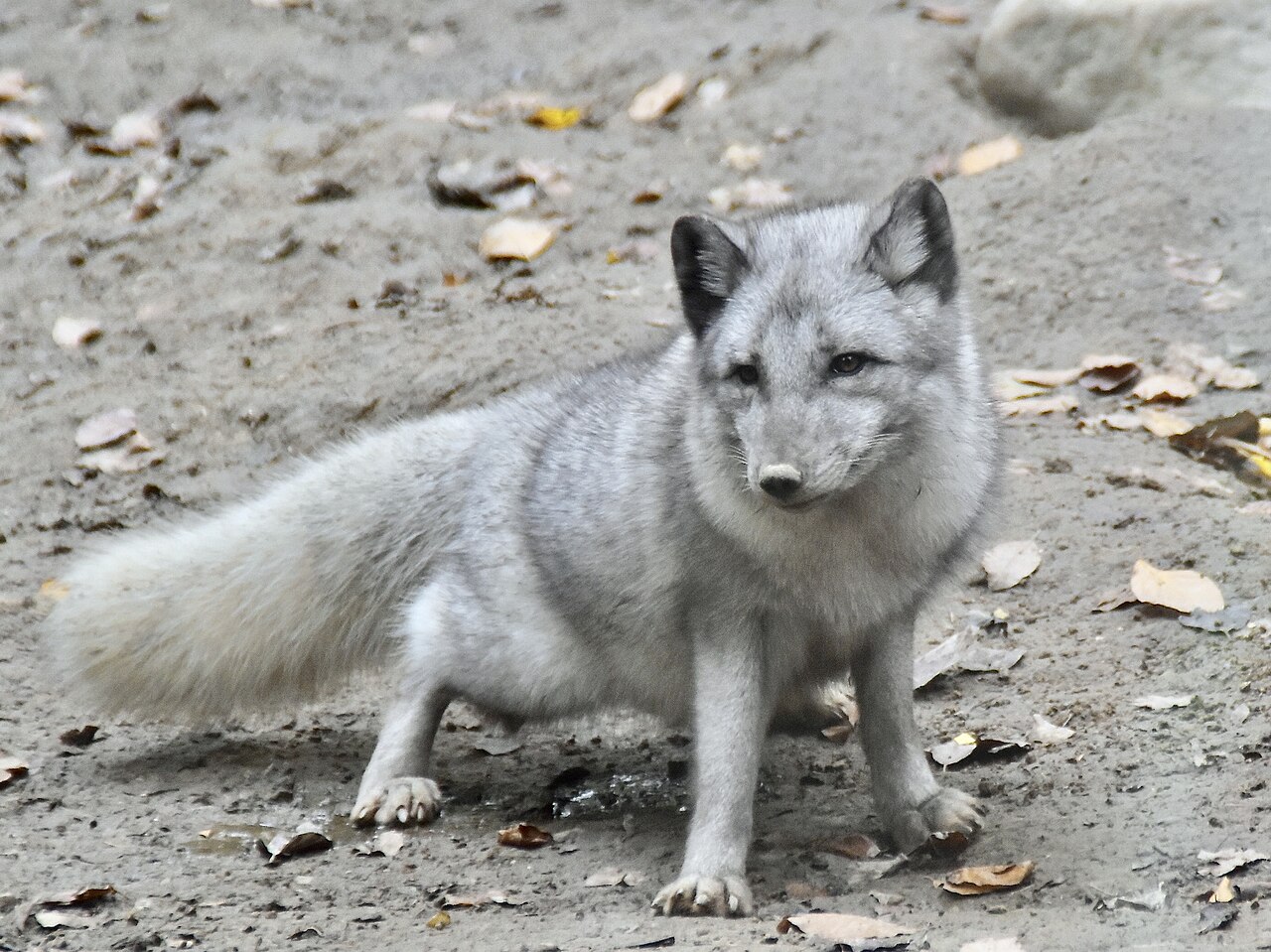
Multiple morphs are tied to The Arctic Fox (Vulpes lagopus), a species most often known for its camouflaging white color.
This furry animal has a multi-layered coat and even has all of its body, including the bottom of its legs, covered in fur.
This allows foxes of the species to live in some of the coolest places on Earth.
Arctic foxes are adapted to long winters by reducing their activity but not by going into hibernation.
Rodents make up the bulk of their diet. These types of foxes are mostly carnivores, often also eating carrion.
They can deal with fish, lemmings, and other species they can find in their coastal habitats and may even resort to eating carrion and feces in periods of starvation.
Most foxes of this type are actual prey for other animals and may not live more than several years as a result.
5. Snowy Owl

Owls also like the tundra but with specific adaptations. Snowy Owls (Bubo scandiacus) are among the diurnal and nocturnal predators that are mostly white and live in the tundra.
Males are dominated by white sections while females show additional brown streaks but still have mostly white appearance.
Snowy owls live and breed in The Arctic tundra. They live in Alaska, Canada, and Northern Eurasia, including Siberia.
Overwintering takes place further South.
Much of their days are spent roaming around vast open areas of mosses and shrubs. It’s here that they look for food, which is mostly based on lemmings.
It’s estimated that around 20.000 Snowy Owls still live in the wilderness today.
6. Rock Ptarmigan

Mostly found across Alaska and The Canadian Tundra, Rock Ptarmigan (Lagopus muta) is a species that also lives in Northern Europe and Northern Asia.
White, gray, and black, this is a type of bird known for its distinct croak-like sounds which give it different names across its different regions.
Rock Ptarmigans dominate territories of various tundras such as those in Canada.
This is a species that’s prevalent in Canada. It is even the official bird of Newfoundland and Labrador.
Mostly eating plants, this type of bird changes its appearance with the breeding seasons.
Males are mostly white with a red crest but they become mostly gray or gray-brown going into the breeding season.
7. Northern Red-backed Vole

Often seen as the main prey for many species of tundra animals, Northern Red-backed Voles (Clethrionomys rutilus) are named after their red dorsums.
This is a species found throughout the various tundra of the world, including North America, Asia, and Europe.
However, these types of rodents aren’t exclusive to the tundra.
They are also seen in forests such as those of the taiga.
Northern Red-backed Voles have a complex diet based on plants (leaves and stems), small fruit, moss, lichens, and other types of vegetation found in these unhospitable habitats.
8. Lemmings
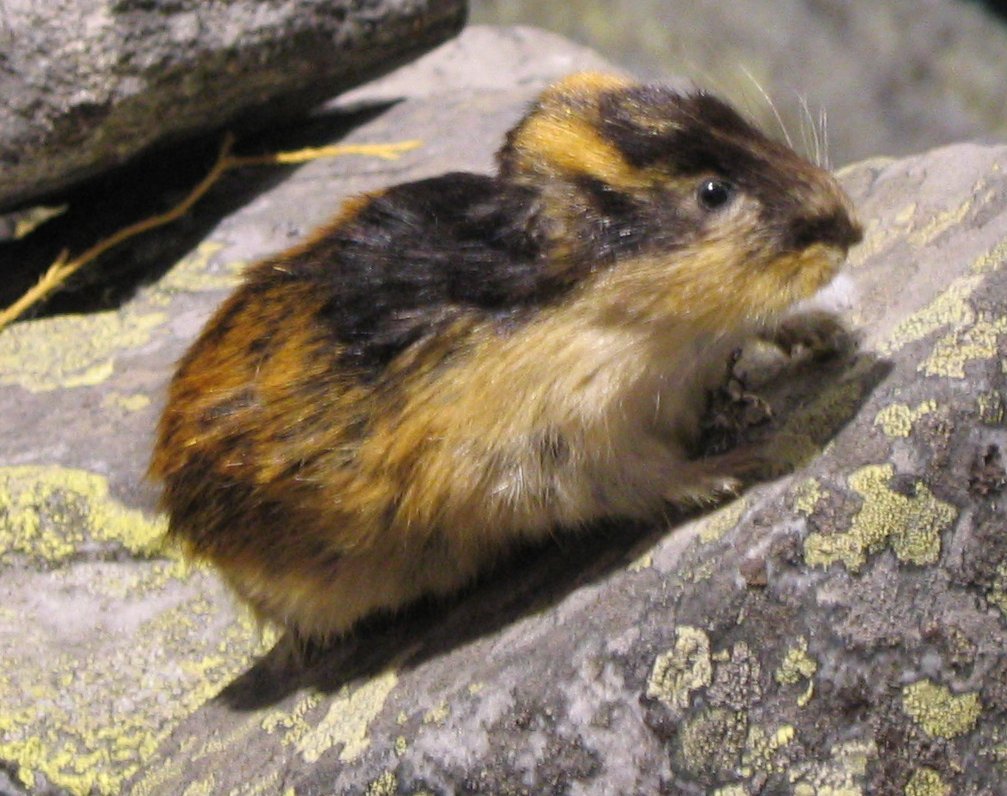
From the tundra of Northern Russia to West Norway, lemmings are a common sight across Eurasia.
They are also found across Alaska and the Northern Arctic. Lemmings are further found in alpine tundra in temperate climates.
This rather round-looking type of rodent is a common sight even in the tundra covered in snow, as it makes its way around under snow for food.
Population can explode at times or they can be limited, depending on their breeding habits.
Darker color lemmings are a common sight in the tundra. Even white lemming such as The Arctic Lemming are among the species seen in the tundra.
Lemmings remain active throughout the year. Rodents of the species are very good at finding chewable vegetation to feed on even in difficult conditions such as those in the tundra.
9. Arctic Mosquito
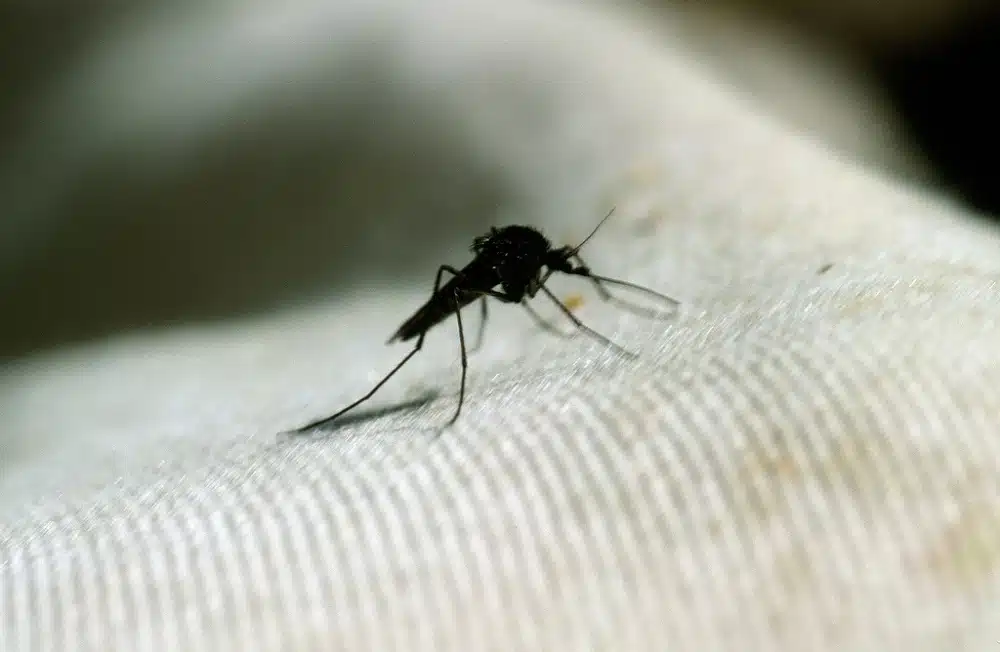
One of the least likely species to live in the tundra is The Arctic Mosquito (Aedes nigripes).
Larger and more aggressive than tropical mosquitoes, this is a species seeing growth in numbers and distribution with climate change.
Arctic Mosquitoes also live in the tundra and they’re quickly identified by their contrasting colors and large size.
Similar to bees in size, these mosquitoes are highly aggressive.
They aren’t too many animals around for them to bite, so if they find one, they bite multiple times, often in groups.
Unlike tropical mosquitoes, Arctic Mosquitoes don’t carry diseases.
Still, it’s believed global warming allows them to spread out quicker and for their survival rate to increase exponentially.
10. Polar Bears

Polar Bears (Ursus maritimus) are one of the largest species in the tundra. Known for their all-white appearance, polar bears live in Northern Canada, Greenland, Norway, Russia, Alaska, and Canada.
A type of sea mammal, Polar Bears only live on ice, or close to water.
Their diet influences this atypical habitat. Seals make up the bulk of their diets with polar bears sometimes eating walruses as well.
A distant relative of grizzly bears, polar bears can swim despite their impressive size and weight.
Males are larger, sometimes twice as large as females. A male polar bear can weigh up to 1,500 lbs.
While polar bears do not hibernate, females den right on sea ice, entering a period of lower activity, similar to actual hibernation.
11. Arctic Wolf

Arctic Wolfs (Canis lupus arctos) are identified by their all-white coloring and their cool habitats, even within the tundra.
Living in packs, these types of tundra-based animals are fierce predators.
They even take on very large prey given they can do it in packs.
Muskoxen is, arguably, the most important food source for Arctic Wolves.
Evidence shows Arctic Wolves living in areas with plenty of muskoxen breed in higher numbers.
These types of tundra wolves are found in high numbers in The High Arctic Tundra. The territory covers some of the most remote Northern Canada islands such as Queen Elizabeth Islands.
12. Arctic Ground Squirrel
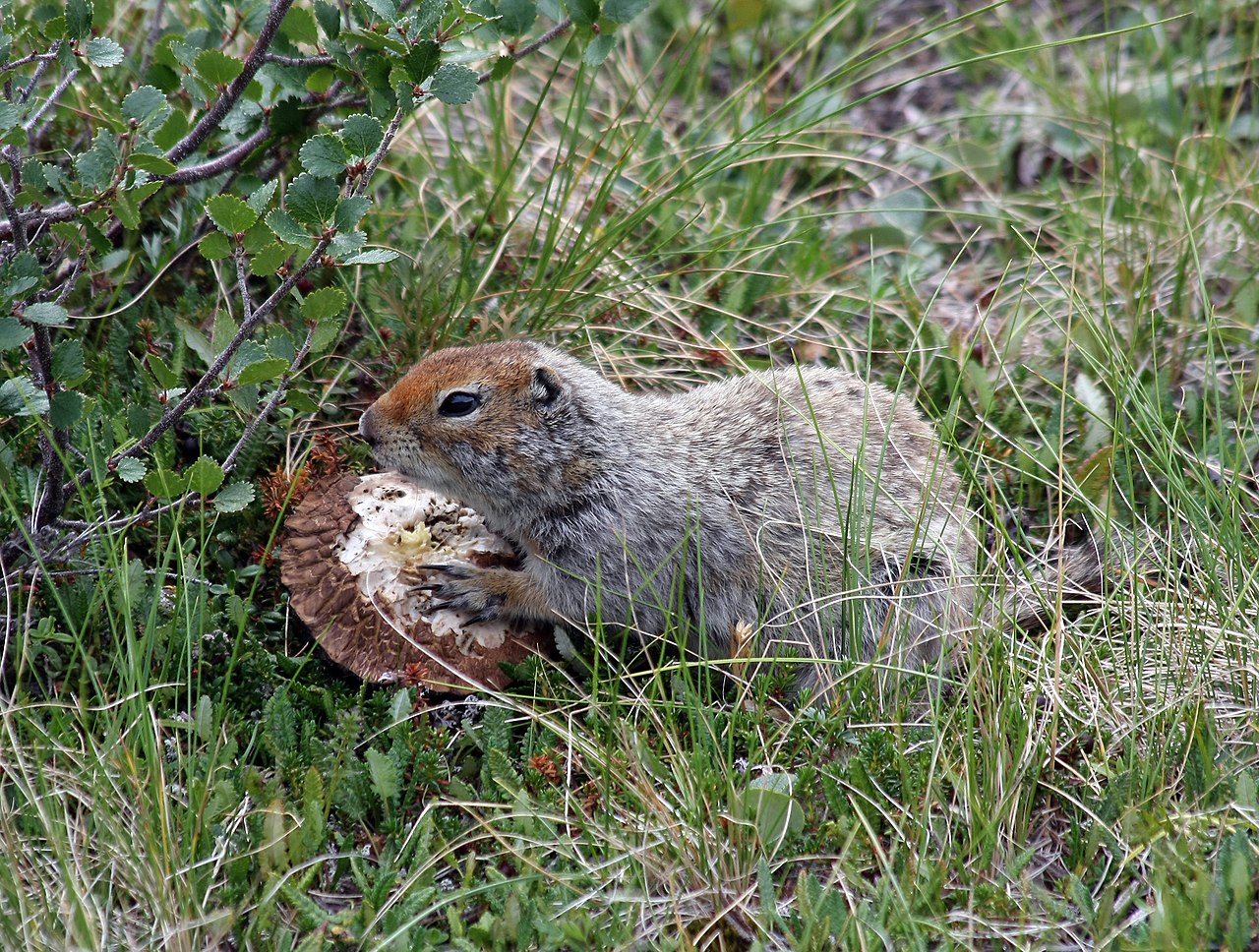
This type of squirrel (Spermophilus parryii) is found in The Arctic Tundra and the Northernmost territories of North America.
Preferring sandy soils and areas with vegetation, these squirrels feed on seeds, mosses, mushrooms, and other types of vegetation.
A preference for sandy soils is specific to the species but these squirrels can also dig into snow.
Arctic Ground Squirrels are also among the species with the longest hibernation.
They can hibernate for most of the year, sometimes up to 8 months in a row.
Squirrels of the species can enter hibernation as soon as August, as temperatures start to drop.
13. Jutta Arctic

Wet areas of tundras are home to Jutta Arctic butterflies (Oeneis jutta).
This is a species specific to the Eurasian tundra, spreading to Siberia and into Eastern Russia.
Jutta Arctics have a bright brown color with bright brown forewings and hindwings.
Yellow spots are seen on the sides of its wings which contrast with the dark brown spots of the area.
White margins are the only truly bright section of the butterfly when seen dorsally.
Its ventral wings show dark brown mottling which helps the butterfly improve camouflage.
14. Arctic Bumblebee
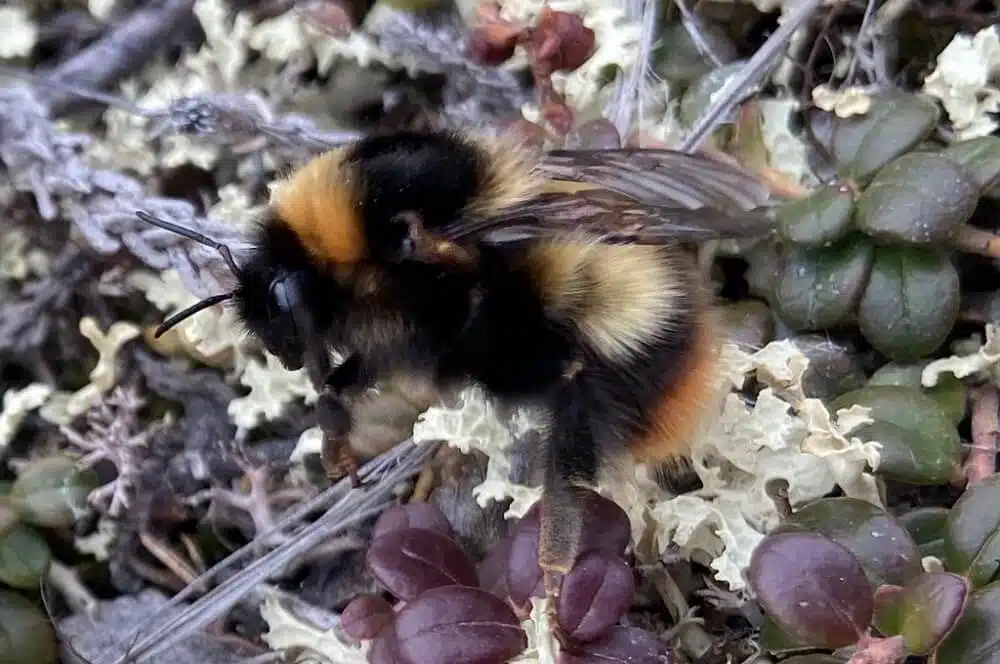
Arctic Bumblebees (Bombus polaris) are among the few bees that live beyond the Arctic Circle.
This is a social species adapted to extreme conditions of the tundra which survive by queen alone.
The queen Arctic Bumblebee is responsible for building the nest and is the only bee of the species to hibernate or survive the long winters of The Arctic Tundra.
The bee is hibernating for months, sometimes 6-8 months in a row.
Only becoming active in the spring, queen Arctic Bumblebees lay eggs as they don’t need to mate anymore for their first worker bees.
Some of the unique lengths the queen goes for her colony include nest insulation to maintain high temperatures inside. They do this by generating heat.
15. Arctic Woollybear Moth
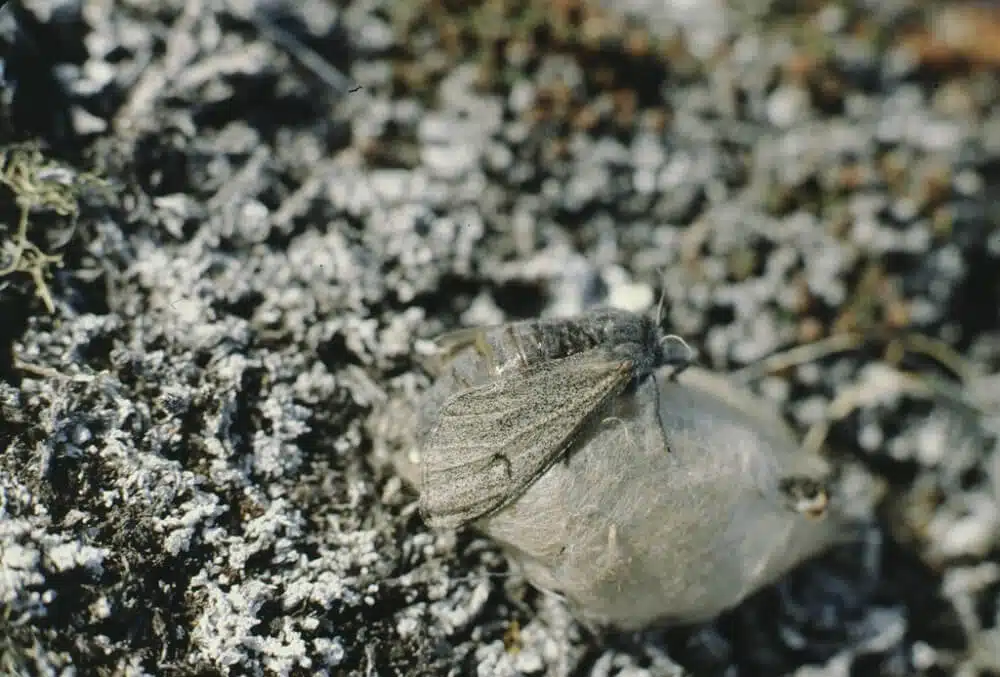
The Arctic Bumblebee is a species that gets almost wiped out every winter in the Arctic Tundra, with the queen as the sole survivor.
Arctic Woolybear Moths (Gynaephora groenlandica) don’t have an easier life either.
It takes anywhere between 5 and 12 years for the caterpillars of these moths to pupate.
Each summer, they grow a bit more, to eventually also enter a hibernation-like status before growing some more the following summer.
Known for its fuzzy appearance, this type of moth has caterpillars that pupate for an average of about 7 years.
Even this long lifecycle is based on the principle of full sun exposure for its caterpillars.
16. Snow Bunting

Snow Buntings (Plectrophenax nivalis) might look like small birds, but they are some of the most resilient species and the first to arrive in The Artic Tundra in the summer.
A highly migratory species, Snow Buntings are among the birds that go to extreme lengths to survive in these habitats.
Most of these birds are found in the tundra of The Arctic, in North America, Europe, and Asia.
They can also be found beyond The Arctic Circle and considerably further South, inland.
Birds of the species survive treeless tundra habitats by building nests among rocks, to have at least minimal protection from predators.
17. Tundra Vole

A species adapted to low food availability, Tundra Voles (Alexandromys oeconomus) are common rodents of The Arctic Tundra.
This species doesn’t hibernate and manages to tunnel itself through the snow and through the low-growing vegetation in the summer.
Tundra Voles are adaptable when it comes to food. They can survive on plants alone but often eat any seeds they can find.
Most Tundra Voles also practice food storage, keeping their foods underground for the days of winter.
A North American native, the Tundra Vole can grow to a size of up to 7 inches.
18. Beluga Whale
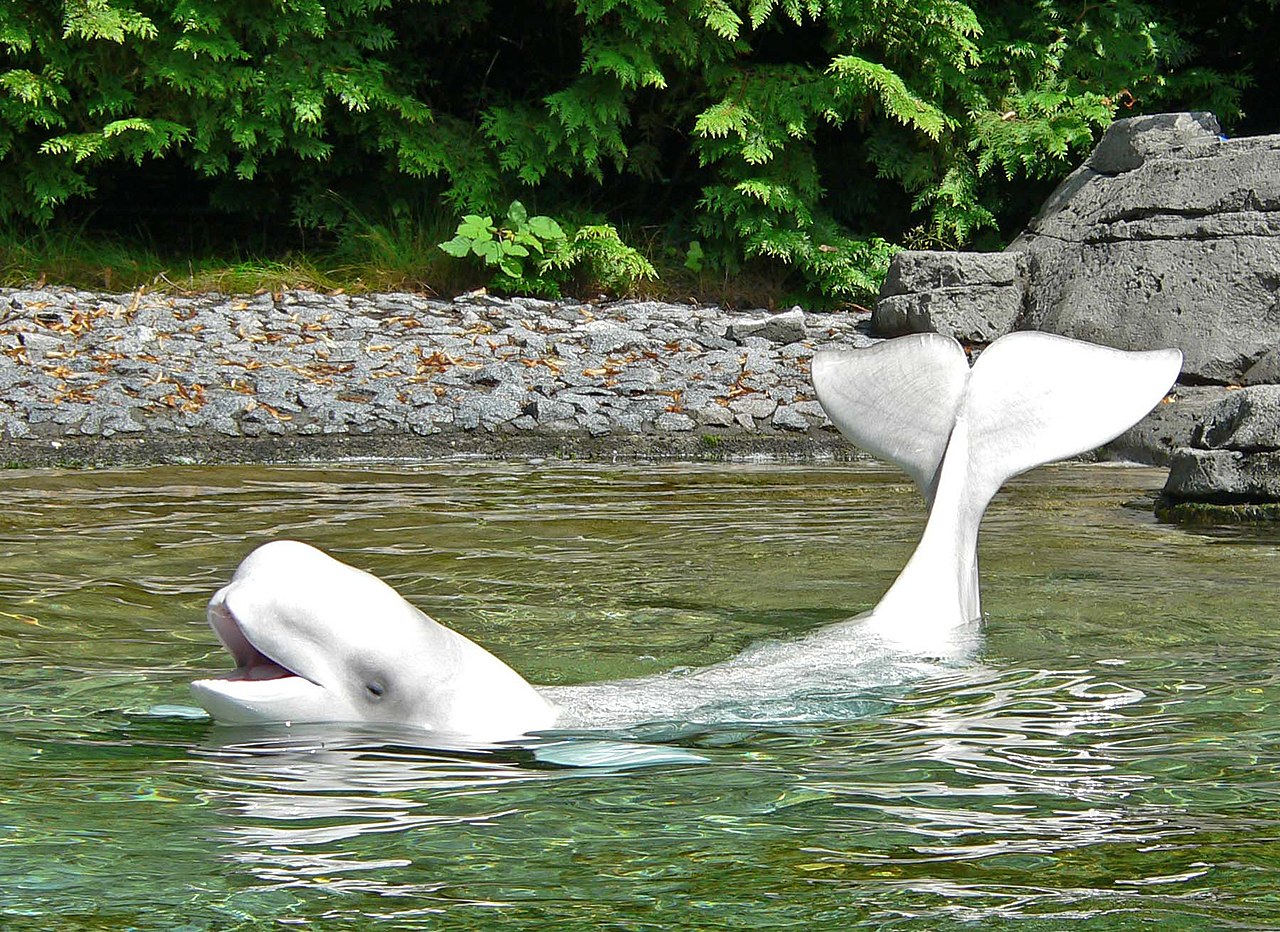
Beluga Whales (Delphinapterus leucas) are also known as White Whales and live in The Arctic and Sub-Arctic.
The species is one of the many all-white species of The Arctic Tundra, despite being a type of whale.
Most notably, its large forehead and high-pitched calls are what make the species famous in aquariums around the world.
A species often found along the coast in shallow water, Beluga Whales are migrators and may not be able to come to shore in the winter.
Most winters are spent out in the open sea as freezing waters block their access to the summer routes.
Each group of whales has a different migration pattern, which is inherited. Some belugas travel shorter distances but most can cover thousands of miles when migrating.
19. Walrus
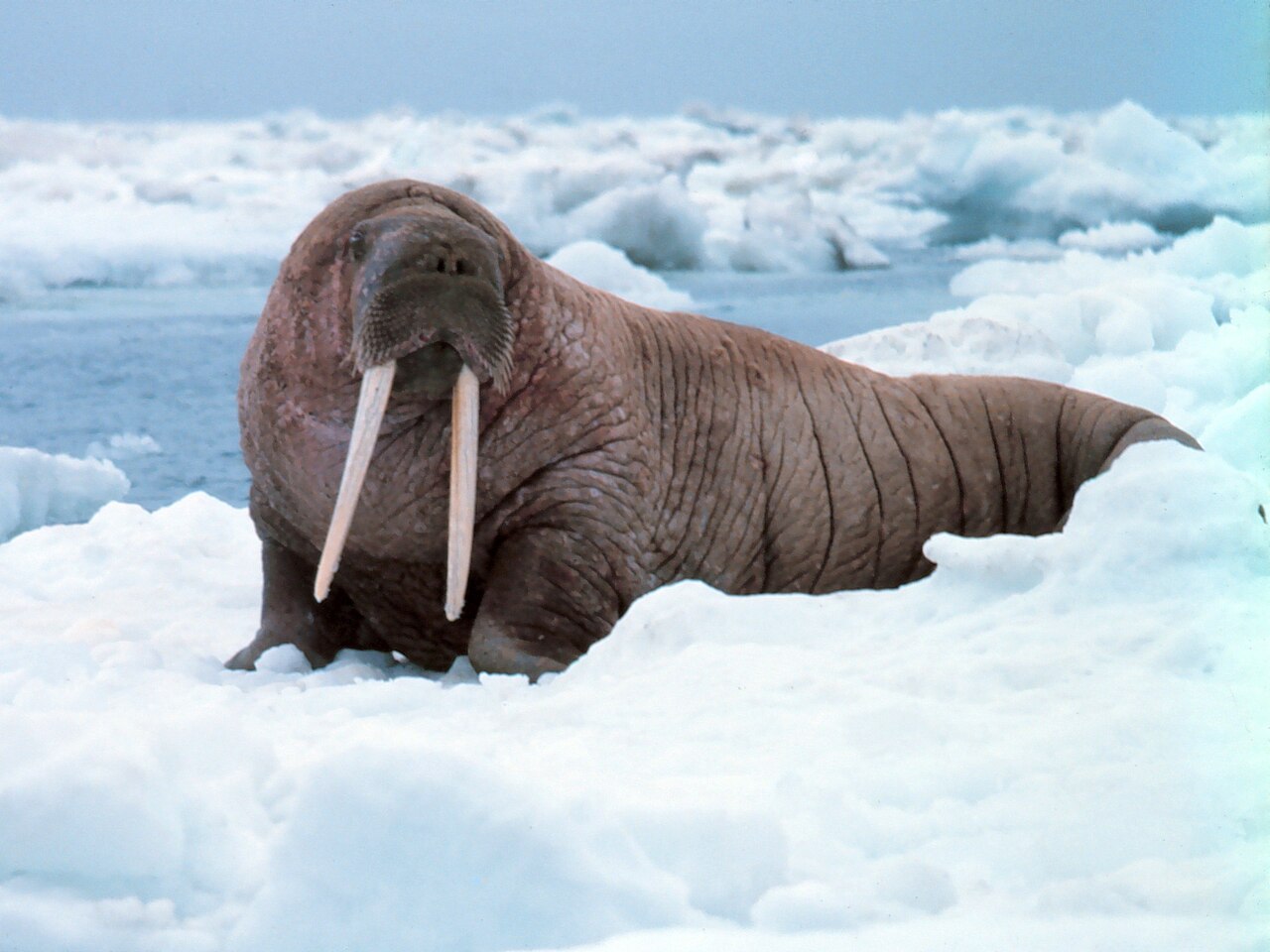
Living in large groups out at sea or on the shore, Walrus (Odobenus rosmarus) are among the heaviest types of Arctic Tundra animals.
This is a species that weighs almost twice as much as a polar bear and which is sometimes hunted by polar bears.
Walruses have characteristic tusks, which resemble the tusks of elephants.
Walruses are also some of the most hunted animals of the tundra by remote human populations of the tundra.
Today, it’s estimated there are more than 200.000 walruses around the world.
Animals in Antarctic Tundra
20. Royal Penguin

Royal Penguins (Eudyptes schlegeli) are among the representative species of The Antarctic Tundra.
This is a species that has a white face and which lives out in the water.
These types of penguins are among the species with very peculiar breeding habits in this cool tundra.
They travel to Macquarie Island to breed. This is the only place they breed in.
A spectacle of thousands of Royal Penguins is seen here every year.
Females lay eggs in October, about a month after mating. Both males and females take care of the young for several months until they’re ready to move out on their own.
Females also provide krill or small fish for males taking turns in warming the eggs and the emerging young penguins.
21. King Penguin

Quickly identified by its mostly white appearance with yellow sections on the upper chest and orange cheeks, King Penguins (Aptenodytes patagonicus) are found around The Antarctic and the small islands around The Antarctic.
This type of penguin is a known diver. It typically dives several hundred feet although it can sometimes dive deeper for rewards such as krill.
Some of the best spots to see The King Penguin include South Georgia and The South Sandwich Islands.
They are also seen in zoos around the world, places where up to several hundred King Penguins live in captivity.
Some of the most common threats to King Penguins include global warming and overfishing.
22. Antipodean Albatross

Antipodean Albatrosses (Diomedea antipodensis) are found in a widespread habitat from The Antarctic Tundra to Chile.
These types of birds are rather vulnerable to predators and are dependent on the tundra to build nests that don’t face too many predators.
Mostly white, this species nests on the ground among the short grasses of the tundra.
Male and female Antipodean Albatrosses are known for their breeding habits which can last months and even years.
Once they breed, males and females remain together for life.
23. Antarctic Fur Seal
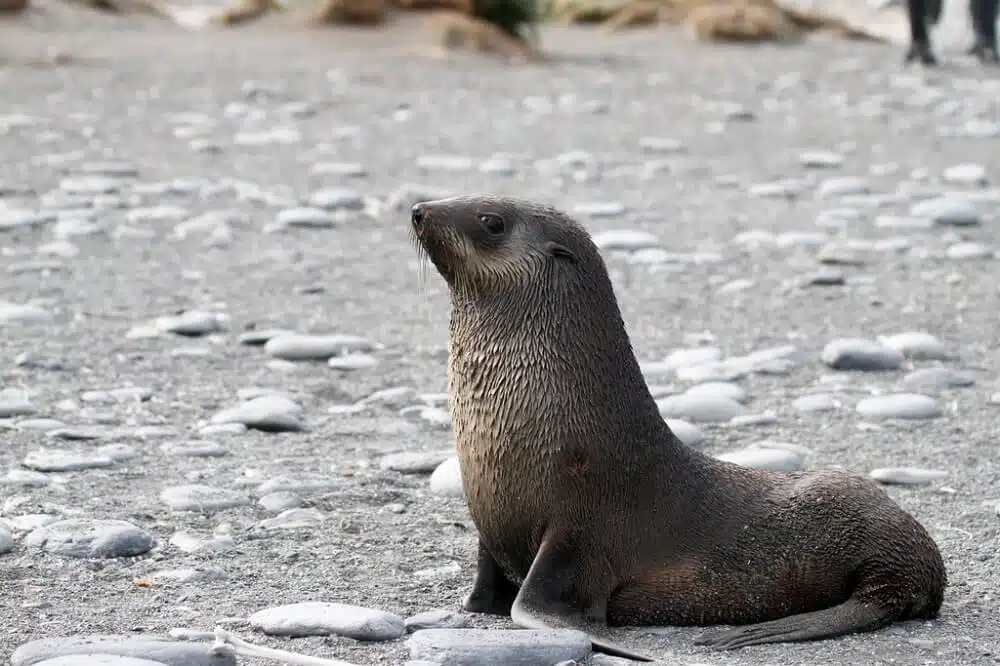
Much of the lives of Antarctic Fur Seals (Arctocephalus gazel) have been well-documented.
This is one of the most common seals in the world which inhabits the tundra habitat of South Georgia Island.
This 100-mile stretch of land is home to some of the rarest animals of the world and to some of the most important animals of The Antarctic Tundra.
The island is believed to be the home of almost all Antarctic Fur Seals in the breeding season.
Up to 6 million Antarctic Fur Seals are found here where the seal pups also grow for a few months.
South Georgia is a territory Antarctic Fur Seals share with species such as King Penguins.
24. Southern Elephant Seal

Known for its large proboscis, Southern Elephant Seals (Mirounga leonina) are found in a widespread habitat from The Antarctic Tundra to New Zealand.
Almost all seals of the species live on the Kerguelen Islands, a remote area of The Southern Indian Ocean.
These seals are also found on Macquarie Island.
These large seals are known for their weight as well. An adult Southern Elephant Seal can weigh up to 1.900 lbs and grow to a length of almost 10 feet.
25. Gentoo Penguin

Gentoo Penguins (Pygoscelis papua) grow to 35 inches and are identified by the white lateral sections on their heads.
These types of penguins roam around The Antarctic Tundra and multiple islands where they breed every year.
Islands they are found in include South Georgia and The Falklands.
Penguins of the species nest further inland compared to other penguins, preferring grassy areas off the beach to lay eggs in.
Unlike other penguins, Gentoo Penguins even switch up the grassy tundra they lay the eggs on for the freshest grass areas.
Like other penguins, they eat fish and krill but are also prey to seals and kelp gulls.
26. Brown Skua
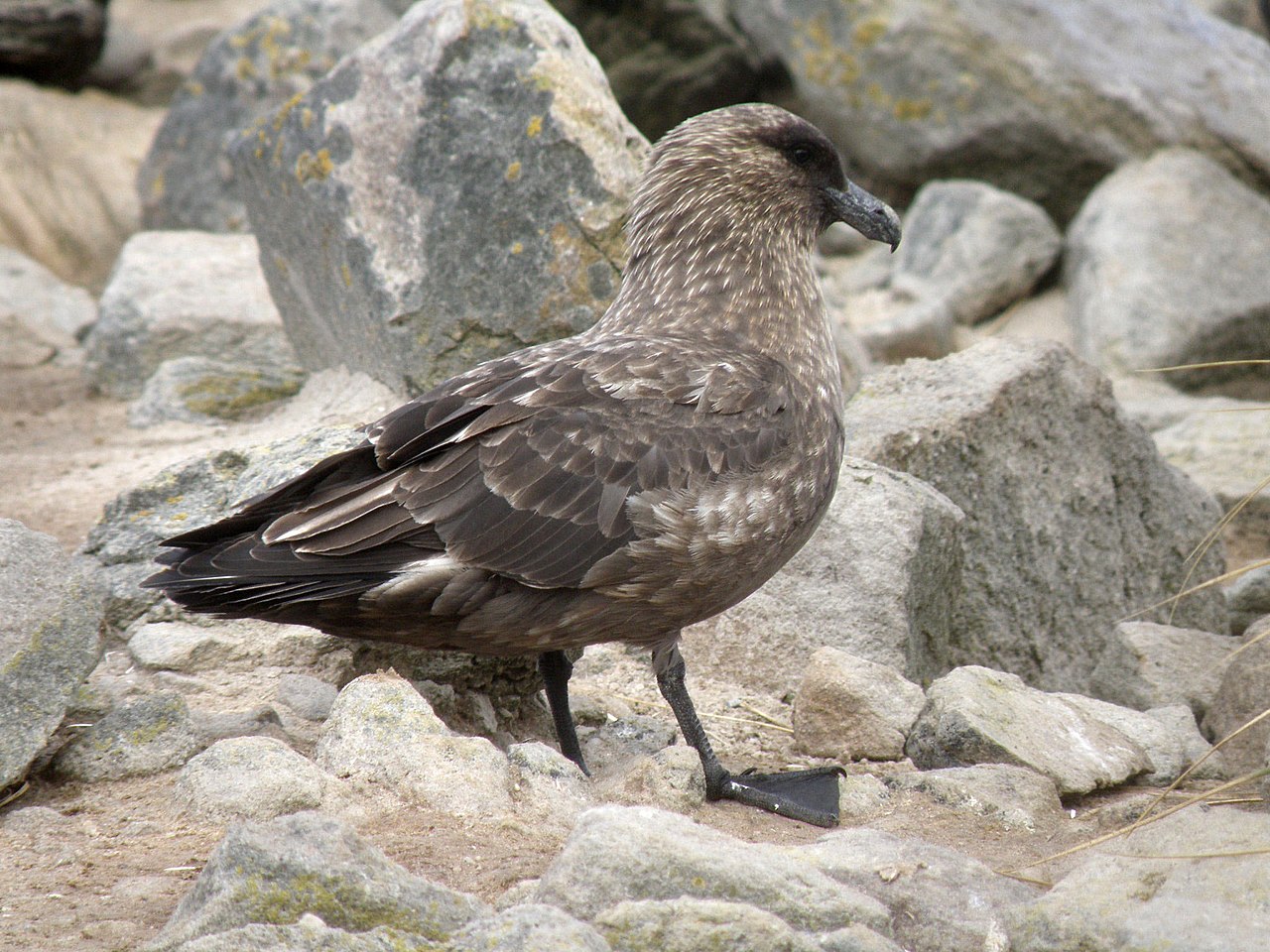
Brow Skuas (Stercorarius antarcticus) are named after their dark brown to black plumage.
These are birds that live in The Antarctic Tundra in the breeding season, flying North outside of the breeding season.
Predatory feeding habits are specific to these large birds, which are as large as some of the biggest gulls in the world.
They can eat small fish and eggs and are frequently known to eat carrion as well.
Brown Skuas are also some of the more frequent predators of penguin chicks.
27. Emperor Penguin

Snow Island and The Antarctic Peninsula are some of the areas of the tundra where Emperor Penguins (Aptenodytes forsteri) breed.
Most Emperor Penguins breed right on snowy patches on beaches, on the other hand.
Colonies breeding in snow-free areas of the tundra are scarce and believed to be diminishing.
Growing to a size of over 45 inches, these penguins are mostly breeding in snowy patches such as on Snow Island, where females lay pear-shaped eggs.
Both males and females take turns in feeding the newly-hatched chicks, mainly with regurgitated fish or krill.
28. Snow Petrel

Snow Petrels (Pagodroma nivea) are some of the resilient birds of The Antarctic Tundra. They have even been recorded to reach The South Pole.
The mostly white bird breeds around Antarctica and the small islands around it. Most move to open sea for food but some colonies remain on the breeding islands throughout the year.
Snow Petrels only build nests in rocky areas of the tundra. It’s here they seek out protection for the eggs and chicks.
Each chick is the result of a long-term male-female partnership. Male-female bonds tend to last for life in Snow Petrels.
Animals in Alpine Tundra
29. Kea

Keas (Nestor notabilis) are a family of parrots endemic to the high-altitude habitats of Sothern New Zealand.
Birds of the species live up in the mountains where they are mostly spotted by campers or backpackers.
Curious and even aggressive, Keas is often an issue for hikers and their personal belongings.
Apart from its curious relationship with humans, Kea parrots only depend on vegetation to survive.
A species not adaptable to captive breeding, Kea parrots live in small groups.
This eusocial parrot even breeds in groups with males breeding with more than one female in the group.
Approximately a few thousand Keas live on New Zealand’s South Island, their limited habitat in the world.
30. Opulent Tiger Moth

This colorful moth (Arctia opulenta) is found across multiple types of tundra, including alpine tundra.
It also shows high populations across The Arctic Tundra.
The colorful moth is known for the differences between its forewings and hindwings.
Brown nuances dominate its forewings which are contrasted by white patterns.
Its hindwings have orange-red coloring, with black spots, similar to the appearance of its body.
A species adapted to cooler temperatures, Opulent Tiger Moths also have hairy caterpillars that like to bask in the sun to warm up.
Its caterpillars also share red-orange and black nuances.
The long hairs of these caterpillars may trigger mild skin-level allergic reactions when touched.
31. Mountain Goat

Living at high and very high elevations, Mountain Goats (Oreamnos americanus) are among the typical species of the alpine tundra.
These all-white goats are primarily found across The Rocky Mountains, also known as Rocky Mountain Goats.
High elevation may seem like an inhospitable environment for these wild goats but it’s a space where they have no real natural predators they would face at lower elevation, such as bears or lynxes.
Females of the species are further known to be aggressive and are the most likely to engage in a fight with predators in areas where the goats need to get lower.
Some of the rare instances these goats come down in elevation include prolonged periods of bad weather.
32. Bighorn Sheep

Bighorn Sheep (Ovis canadensis) also live in the alpine tundra. They are present in North America, believed to have migrated from East Asia a long time ago.
This is a species identified by the big curved horns of rams. These horns have fascinated people for a long time.
The fascination with the horns, together with the feeding capacity, led to most Bighorn Sheep in North America being highly sought after by hunters.
This is a heavy type of sheep, reaching weights of over 300 lbs, which has always made it a target as a meat source.
Males of the species are further known for relying on their curved horns to fight off another male in mating rights with ewes.
Bighorn Sheep are sometimes confused with the similar-looking Asian-origin Argali Mountain Sheep, a species of The Himalayas and Altai Mountains.
33. Himalayan Tahr

This species (Hemitragus jemlahicus) is closely related to goats and sheep and it can be found around the high Himalayas.
A type of wild goat, The Himalayan Tahr also has curved horns, but are slightly shorter than those of Bighorn Sheep.
Wild goats of the species are mostly found across the mountainous ranges of Nepal, where they share the same difficult habitat as other wild goats such as argali or blue sheep.
Himalayan Tahr has also been introduced around the world.
Small populations are found across New Zealand and Argentina. However, their impact is considerable as Himalayan Tahrs feed on different almost extinct local plants.
The digestive system of the species is also rather complex. These wild goats have multiple stomachs and can regurgitate chewed food to eat it as needed.
These wild goats can also be aggressive towards each other in areas with low food availability.
34. Yak

Yaks (Bos grunniens) are a type of Tibetan Plateau cattle. These types of cattle are among the few in the alpine tundra to be domesticated.
Milk production is the main reason for the domestication of yaks in this area. A low number of species capable of living at high altitudes is also a reason why yaks have been domesticated.
Yaks, unlike regular cattle, are adapted to living in alpine tundra at high altitudes, an area where oxygen levels are lower.
These adaptations include having larger lungs than other species and the capacity to transport oxygen better.
This is why Yaks have no problem even running at high altitudes.
Yaks are further used
as a means of transport and in agriculture.
35. Snow Leopard

The Snow Leopard (Panthera uncia) is another species of The Himalayas and Central Asia adapted to alpine tundras.
Leopards of this type are white-gray with black spots and are known to live in some of the most remote areas of rocky slope tundra.
True hunters, Snow Leopards are among the most common predators of wild animals and domestic animals.
Some of the wild animals eaten by Snow Leopards include The Himalayan Tahr.
An agile creature, Snow Leopards are known to use their steep slope habitats to pounce on prey.
36. Pikas

Rocky areas and slopes of alpine tundra are home to small pikas.
This is a species found both in Asia and North America. It only lives at high elevations.
While small, Pikas are among the alpine tundra mammals that make distinct calls.
These calls can be short or long but are typically loud enough for communication. They can alert other members of the species about potential predators.
Pikas also have distinct identification calls which help each stand out within an area.
Finally, Pikas also have distinct mating calls males make to attract females.
37. Canada Lynx

The boreal forest and tundras of Canada are home to The Canda Lynx (Lynx canadensis).
A type of cat, Canada Lynxes are larger than a domesticated cat and can also be found across the forests of Alaska.
This hairy type of wild cat is an excellent predator with known dietary preferences.
Large and slow animals such as hares make up the bulk of their diets.
Canada Lynxes may also eat other types of prey such as moles and squirrels.
However, Snowshoe hares are their main food choice and one of the main reasons why Canada Lynx numbers are as variable as the variable numbers of hares.
38. Tundra Swan

From Siberia to North America, The Tundra Swan (Cygnus columbianus) is one of the few large birds that live in the tundra.
This mostly white species has a black beak tip and live in flocks.
Migration patterns are also tied to the species which move from lakes and beaches to grassland or further inland.
The species feeds on aquatic vegetation in the summer by plucking its head underwater.
Some of their common predators include brown bears as the nests are often within their reach in the tundra.
39. Coyote

Coyotes (Canis latrans) look like smaller wolves and are native to North America.
The species has a long history in the culture of natives and is today known for its opportunistic diet.
Coyotes can survive the tundra as they can eat almost anything. From fish to deer, they make the most of whatever animal they can overpower or of whatever carrion they find.
The species is also known to communicate and form family groups where both males and females take care of the young.
40. Red Fox

Red Foxes (Vulpes vulpes) are the most common type of carnivore of the tundra. This is also one of the most common types of wild animals in the world.
Unlike solitary species, Red Foxes are spotted in small groups across the tundra where they can find different types of food to live off.
Mice and squirrels are among the multiple small animals these foxes feed on.
They can also eat plants and fruit, albeit to a lesser extent.
Some of the best periods to spot Red Foxes in the tundra include early morning or just before nightfall as this is when they come out for food.